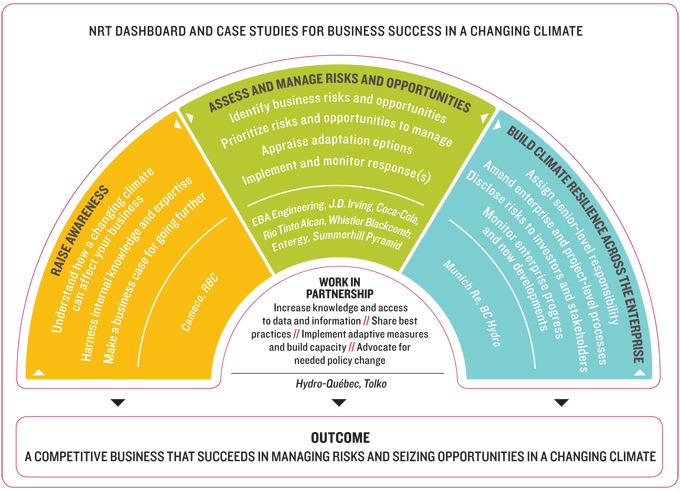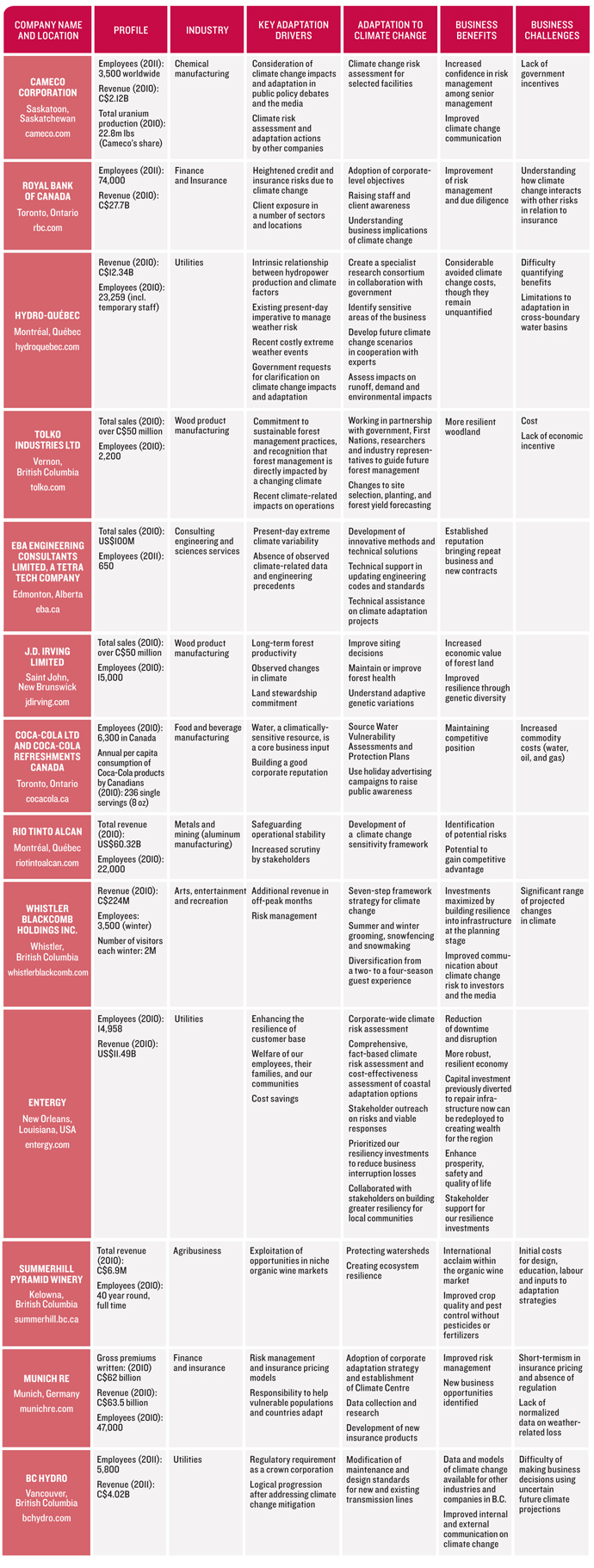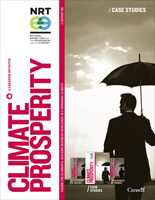Facing the Elements: Case Studies – Lessons Learned
Building Resilience
Climate change means business. Canada’s firms have a key role to play in mitigating the speed and scale of climate change through carbon management. But because some degree of climate change is inevitable, businesses also need to adapt to those irreversible effects. Firms are increasingly familiar with tactics and strategies to reduce their carbon footprint, and are now looking for practical tools, best practices, and lessons learned from other businesses to help them understand climate change risks and opportunities for themselves and what it means to develop, and implement cost-effective strategies to adapt.
This case studies report presents successes, challenges, and key lessons of thirteen Canadian and international companies as they discover the business implications of climate change, assess and manage risks and opportunities, and build climate resilience across their enterprise.a By building resilience, firms can respond quickly and recover readily from events beyond their control. The case studies show that adjusting business practices in light of changing climate is not only feasible but these actions offer real benefits in preserving and creating value. But, more importantly, they illustrate practical and tangible steps applicable to a range of firms.
This is not just about coping with climate change, but prospering through it.
This report, and its two companion reports that provide advice to governments and advice to business — Business Summary and Advisory Report — are part of the NRT’s program on the economic risks and opportunities of a changing climate called Climate Prosperity. The NRT is exploring the economic implications to Canada resulting from a changing climate, how we should adapt to it, and what this will cost.
Our work on business resilience in the face of climate change follows two earlier NRT reports that describe the impacts for our country of a changing climate and make a strong case for climate change adaptation to minimize negative impacts and exploit opportunities. Published in 2010, Degrees of Change: Climate Warming and the Stakes for Canada, highlighted a wide range of physical impacts of climate change that we can expect in Canada over this century. In 2011, we released Paying the Price: The Economic Impacts of Climate Change for Canada, in which we estimated the economic costs of climate change for the country as a whole and for coastal areas, forestry, and human health in particular. Now, we are turning our attention to considering how business can adapt to climate change by building resilience in their assets, operations, supply chains and decision making.
Selecting and working with case study companies
By design, case studies cover a range of industry sectors. But coverage of diverse industry sectors was just one criterion among several. Geographic coverage, availability and depth of publicly disclosed information, evidence of benefit to the company from taking steps to adapt, and degree of integration of adaptation thinking within corporate business practices were all important in our recruitment effort. We favoured Canadian companies or multinational companies with significant operations in Canada. In the end, we included three well-known international companies, drawing out transferrable lessons for Canadian firms.
Case study development proceeded in four stages. The first was an extensive review of public information on each company’s actions to adapt to climate change. Telephone interviews were then conducted with representatives from each company. Information from document searches and telephone interviews fed into each draft case study. Finally, each company reviewed and signed-off its case study.
Three limitations in our approach are worth noting, and we discuss them here for the benefit of other organizations seeking to engage business on climate adaptation. First, not all industry sectors of the economy are represented. We were careful to include a balance of goods and service-producing industries with significant importance to the Canadian economy. A notable gap is in oil and gas where we were unable to recruit a case study firm. Second, throughout the economy, firms are likely making small, incremental changes to supplier relationships, operations or products, and not recognizing that these actions are, in effect, climate adaptation. Here, we focus on planned and deliberate action to adapt, but include a few examples of "unconscious" adaptation. Finally, confidentiality concerns can constrain disclosure of actions to assess and manage risks of changing climate. Concerns stem from competition, and the perception of a public position on adaptation appearing defeatist or cavalier toward climate change mitigation. The case study companies we showcase are quite possibly atypical in their level of comfort in presenting their actions publicly.
Business strategies to succeed in a changing climate
In a changing climate, firms that routinely incorporate climate change impacts and adaptation in major investment decisions and in decisions with long-term consequences will be better off than their competitors. So, we provide a roadmap for business success in a changing climate broken down into three phases. Because the range of climate and physical effects (and in turn the range of possible business impacts) is broad, firms first need to understand how shifts in severe weather and more gradual changes in climate conditions affects them. To prioritize actions, firms move on to assess specific risks and opportunities, as well as options to manage them, and on to implementation. A further phase is then to integrate climate resilience across the enterprise – from the boardroom to the copy room. Working in partnership with like-minded organizations is an efficient approach to moving through each of these phases. Gaining access to data and information, learning about good practice, implementing cross-cutting strategies, and successfully advocating for policy change, are all outcomes of collaboration. The dashboard in Figure 1 is not prescriptive. The "right" strategy for a firm will depend on risk exposure and a host of firm-specific factors, including capacity, risk tolerance, and current knowledge of problems and solutions. Some firms may undertake all the steps laid out below, others will instead focus on a few that are most relevant to them.
The thirteen case studies provided in this report profile the actions of pacesetting companies as they move through different phases of this roadmap to business resilience – from the ‘early stages’ of emerging business awareness of climate risk, through to robust integration of climate risk management as a part of doing business. The case studies often illustrate a specific phase or even specific steps within that phase, but do not necessarily paint a comprehensive picture of each company’s strategy.
FIGURE 1 – NRT dashboard and case studies for business success in a changing climate

Factors shaping business adaptation
A common question we hear is "what gets firms started"? Experiences of the thirteen companies suggest that, for firms to "get it", one or more factors need to align: they need to understand the connection between climate impacts and business success; view sustainability as a business imperative; have good risk management systems in place; or have first-hand experience with climate-related events or impacts. As information on climate change and its impacts increases and advice on how to adapt becomes more accessible, stakeholders’ expectations of firms will evolve. Several case study companies are beginning to prepare accordingly. They understand the potential for regulatory risk; legal liability due to failure to proactively consider, disclose, and manage climate change risks; enhanced demands for reporting; and, reputational risks arising from climate change impacts on the environment and local communities.
The experiences of case study companies show the real benefits that can accrue from taking steps to adapt to the effects of climate change. Benefits lie in both value protection, by reducing existing weather and climate-related risks, and value creation, in the near term by exploiting opportunities and strengthening their market position relative to peers, and in the long term by incorporating climate change into capital investments so that assets continue to perform reliably in the future. For example, Albert-based EBA Engineering Consultants Ltd. has built up expertise and reputation for developing engineering solutions robust to shifts in permafrost, ice and winter conditions in Canada’s North, and, with that, considerable business opportunities. Wood products manufacturer, Tolko, expects its timber stands to be able to cope with a range of climate futures because of changes in tree planting practices attuned to the principles of ecological resilience. It also pays to be informed about risk exposure and viable options for risk control ahead of stakeholder demands for this information. Uranium producer, Cameco, conducted a climate change risk assessment that instilled confidence among senior management that no hidden liabilities existed because of climate change and improved its communications with stakeholders on climate change risks and opportunities.
What are government roles in supporting business action to adapt to changing climate? We asked this to the thirteen case study companies and their responses point to both direct and indirect roles. Some companies profiled in this report have directly benefitted from government funding for consortia specializing in regionally-relevant research, and indirectly through government collection and provision of climate data, impacts and adaptation research, tool development, and initiatives to raise awareness of future impacts. As for the future, case study companies offered a number of perspectives on government roles additional to todays: supporting collaboration between business and experts on climate risk management; ensuring the climate resilience of critical infrastructure; clarifying policy and regulatory signals; and, providing financial incentives
What’s the future outlook? This report and others1 show that firms in Canada and around the world are starting to prepare for future climate realities. Since risk management and entrepreneurship come naturally to business, progress with existing information, tools, and capacity is likely. In the years ahead and as the impacts of climate change intensify, enhanced dialogue, collaboration, and focused efforts across private and public sectors alike can only help to minimize the costs of adapting, take advantage of opportunities, and put our economy on a path to climate resilience.
Case Studies at a Glance

[a] This report is based on a consultant report titled A series of case studies of business resilience in a changing climate: lessons from early adapters in Canada and abroad (Acclimatise 2011), available upon request.
[1] United Nations Global Compact et al. 2011; UK Trade & Investment 2011








































